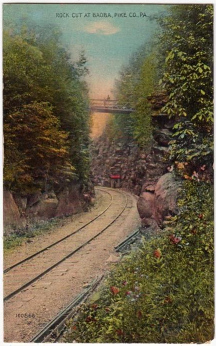Postcard History: Baoba Swinging Bridge and Shimer's Rock Cut
Postcards are curated vignettes of our past, often idealized views of places from a time when it appears people could wander more freely. But if you keep your eyes open and do some research, you’ll find that many of these places are still yours to explore.
Last week a postcard came up for bid that depicted a rock cut in Baoba, Pike County, Pennsylvania, circa 1910. I’m familiar with Pike County, having spent many days there searching for survey marks, geocaching, or just hiking around. But somehow I had never heard of the former village of Baoba (I still don’t even know how to pronounce it—I’m going with BAY-oh-ba).
Edit (24 May 2022): A reader named P.T. O’Neill has just contacted me with the following information:
Hi, came across this post and wanted to give you some input on the pronunciation of Baoba. My maternal grandmother, Rena Waldis, b.1900, grew up on a farm in Baoba, and she pronounced it Bay-OH-ba. So now you know.
Both Google Maps and USGS Topo Maps know Baoba, however. The topo map clearly shows the rock cut, labeled Shimers Rock Cut.
The map also shows a benchmark situated in the cut—NGS bench mark disk T 50. The disk was set in 1934 and an official recovery note has never been submitted to the database. (So what are we waiting for, right?)
The benchmark description refers to the ERIE RAILROAD WAITING SHED. Could the little building shown in the postcard possibly have been the waiting shed? That’s right, there’s only one way to find out.
But the fun doesn’t end here! See that bridge over the river just north of the first “S” in Shimers? Turns out it’s a swinging bridge that has been in place in some form since 1882.
Bridgemeister shares some of his information about “Rock Cut Farm Swinging Bridge” and notes that the although the bridge was most recently washed out in the flood of 2006—one of many floods of the Lackawaxen over the last century—it was promptly replaced. Does it remain to this day? The bridge appears in Google satellite imagery from 2009, but the flood of 2011 may have damaged the bridge once again.
And there’s one more detail that requires on-site investigation: the bridge shown in the postcard that passes over the rock cut. Nothing is visible in current satellite imagery, but PennPilot imagery from 1939 and 1959 show a road and bridge crossing the cut.
Does the road still exist? How about the bridge? It’s time to get out and wander!

